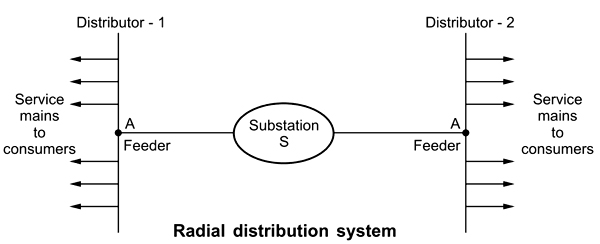The main criterion for selection of the size of a distribution for a radial distribution system is
Right Answer is:
The station is located in the center of the load
SOLUTION
The main criterion for the selection of the size of a distribution for a radial distribution system is station is located in the center of the load.
According to the scheme of connection, the distribution system may be classified as:
(a) Radial system
(b) Ring main system
(c) Inter-connected system
Radial System
- If a distributor is connected to the supply system from one end only, it is called a radial system of distribution.
- This is also true for the feeders i.e. if a feeder is connected to the supply system from one end only that feeder is called a radial feeder.
- The main characteristic of a radial distribution system is that the power flow is in only one direction.
- There are combinations of one distributor and one feeder, connecting that distributor to the substation.
- In distributor 1 is connected only at one end to the substation through a feeder at point A. Similarly, the other feeder is feeding distributor 2, only at one point B.

Advantage of Radial System
- Simple in operation
- Low initial cost
- Useful when the generation is low voltage
- Radial system is preferred only when the station is located in the center of the load
In a radial distribution system, for a given length (l) and area of cross-section (A), the resistance of the conductor is given by
$R = frac{{rho l}}{A}$
Voltage drop is given by V = IR
In order to reduce the voltage drop, the size of the conductor must be increased (for a fixed given length) so that the resistance of the conductor is reduced. Hence rated voltage can be maintained at the load terminal.
Disadvantages of Radial System
- The end of the distributor near to the substation gets heavily loaded.
- When load on the distributor changes, the consumers at the distant end of the distributor face serious voltage fluctuations.
- As consumers are dependent on a single feeder and distributor, a fault on any of these two causes interruption in supply to all the consumers connected to that distributor.
